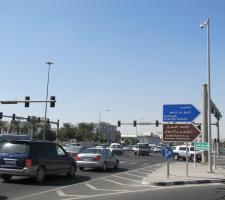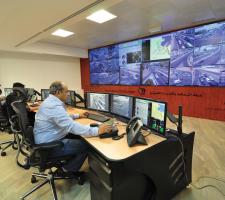
Pan-tilt-zoom IP dome cameras have been installed for CCTV monitoring of 44 intersections, with intent to have all 150 of the city’s road junctions covered by the end of 2013
Expansion of ITS systems has accelerated in Qatar this year, with rapid deployment of a traffic control system in Doha.
Less than 10 years from now an extensive system of ITS technology will be operating in Qatar, informing and directing users of the country’s roads. That can be stated with confidence for a number of reasons: the world’s richest country per capita will host the World Cup in 2022 and is understood to be planning to develop sophisticated systems of ITS for road safety and traffic management in time for the event.Early stages of the plans are already emerging. Earlier this year, Qatar’s Public Works Authority (PWA) activated a new system of traffic control in Doha, the state capital, after very rapid initial phases of development and deployment. The project commenced at the beginning of August 2011 and the first phase was commissioned just four months later, with the control system officially inaugurated in March this year.
Up and running
Doha’s Traffic Control Centre is fully up and running, but with plenty of scope for further expansion. It currently controls CCTV cameras and traffic signals at 44 intersections, but there is intent to have all 150 of the city’s road junctions covered by the end of 2013. This is according to“What we have installed in Doha represents the basic building block for further expansion of ITS systems in Qatar. The Doha TCC will eventually become part of a national control centre. A partnership of Qatar’s Government Ministries is now investigating what is needed in terms of nationwide ITS architecture and standards,” says Traffic Tech chief executive officer Husam Musharbash. “The ITS to be developed is likely to include full systems of freeway management technologies, with comprehensive data collection, traffic monitoring and control, and communication of traffic and travel information.”
Plans developing
Qatar’s plans are developing two-fold. Under the umbrella of a national government traffic and road safety committee (consisting of representatives of several Qatari ministries including the PWA), a national strategy for road safety is being formulated. In parallel, the scope of ITS architecture needed over coming years is being studied, for road safety and traffic management; and in support of metro and light rail networks that will serve Qatar and 12 air-conditioned stadia to be built before 2022. “Overall, the country is aiming for an optimized and integrated transportation system that delivers accurate, reliable and user-friendly information connecting all in Qatar,” says Musharbash.The traffic control operations are expected to be developed in two main parts: one system will manage Qatar’s national network of main freeways and the second will operate systems of urban traffic control. All are expected to be controlled eventually from a new national control centre.
If progress so far is anything to go by, Qatar’s residents and visitors will have a very effective means of getting around before the start of the World Cup.
“Getting projects from stages of planning to full operation in four to five months is usual for this part of the world”, says Musharbash. “Development and operation of the Doha TCC has been taken very seriously,” he adds.
Standing apart
Traffic Tech has also been contracted to operate and maintain the Doha TCC for two years.“To ensure execution of effective traffic management strategies, we have employed a traffic supervisor with over 20 years of experience as a traffic police officer to head the team of control room operators,” says Musharbash. “In addition, an engineer with over 15 years of experience in SCATS manages the traffic signal segment of the system.
“A process of feedback on the operations enables the system to respond to constant increase of vehicles and levels of congestion.” Refinements are being done periodically, which makes Doha TCC operations stand apart from many others, Musharbash says:
“While SCATS operates adaptively adjusting signal parameters each cycle to suit the prevailing traffic conditions, it also provides real time information to the operators on unusual congestion conditions for them to monitor and if necessary intervene manually.
All such recurring congestion conditions are reported by the operators to the SCATS engineer who then plans and executes corrective adjustments.
Operators then monitor the adjustments and report the results back to the SCATS engineer. This procedure ensures that the system continuously improves and adapts to changing traffic conditions.”
The Doha TCC project has involved installation of a SCATS adaptive traffic signal system with CCTV monitoring of intersections via pan-tilt-zoom IP dome cameras. Video management and recording is via an IP system supplied by Traffic Tech, which also installed Doha’s control room with video wall and operators’ consoles through a Design & Build contract with PWA. At the height of its work between August to December 2011, Traffic Tech was fitting out one intersection every day.
The communications element of the project, connecting intersection cameras and signal controllers to the TCC control room, “presented a considerable challenge”, says Traffic Tech marketing manager Vincent Dayap. The solution, to overcome a lack of sufficient and secure bandwidth, is a Multi-Protocol Label Switching IP VPN (virtual private network). This has allowed all operations to be managed centrally, as an interim measure ahead of a citywide fibre optic communications network planned for Doha.
Fine tuning
In operation, the city’s SCATS adaptive control system is fully automatic, says Musharbash: “Using its configured system and traffic related parameters, SCATS dynamically generates optimised area-wide traffic timing plans in real time in response to detected changes in traffic demand patterns. It varies cycle time, signal split, and offset at each controlled intersection with the aim of maximising traffic flows and reducing the number of stops,” he says. “Pre-determined action plans of signal timings can also be executed according to a predefined timetable or matching traffic pattern for special events and unusual traffic conditions.”But, Musharbash says: “There is always room for improvement and if this is possible then it should always be done.”
Observations from multiple live CCTV feeds and recordings of congested intersections are being used to fine tune the system operations to suit what’s happening out on Doha’s road network – to implement corrective adjustments to certain parameters and commands that are read and executed by SCATS at scheduled periods.
“Installation of the citywide CCTV network has proven an obvious benefit to the system overall,” Vincent Dayap says. “In response to SCATS reported ‘congestion’ alarms, operators can use the CCTV cameras to visually determine if they can assist by removing the cause of the congestion, such as vehicle breakdown, accident or illegal lane closure. These and other incidents can now be detected and reported almost immediately, allowing much faster response at the scene and in the TCC for clearing the blockage and traffic congestion. Operators can also make adjustments to the system, but only if necessary. If made, they are logged and reported to the SCATS engineer, who then makes use of this information to prepare standard action plans for operators to implement for handling similar incidents in future.”
So, is Doha’s new system of traffic monitoring and control working to good effect? While Musharbash testifies that Traffic Tech’s client is happy with the results achieved so far, Dayap attests his experiences as a commuter in Doha: “For the daily commute from my house, I usually drive during the morning rush hour along three of the busiest streets in Doha. Last year this journey of about 12km was taking 30 to 40 minutes. Now it takes 25 minutes at most.”













